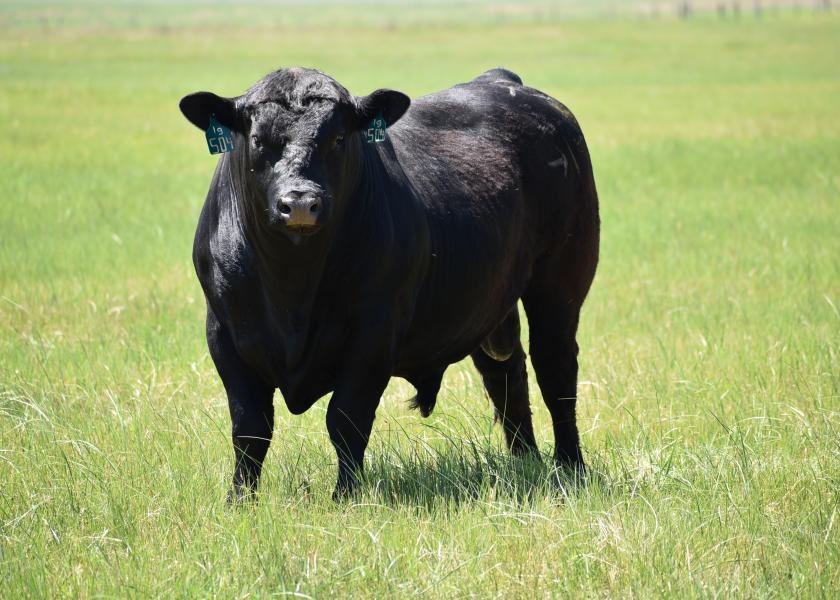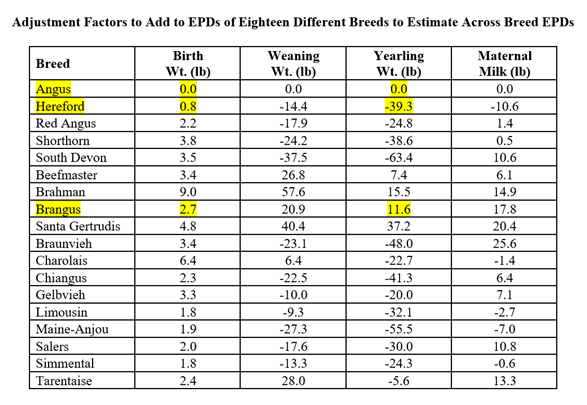Across Breed EPD Adjustment Factors

National Cattle Evaluation (NCE), and the resulting Expected Progeny differences (EPDs), have resulted in substantial genetic change since their inception. Typically EPDs are only comparable within breed; however, since 1993 the U.S. Meat Animal Research Center (USMARC) has produced a table of additive adjustment factors which can be used to compare the genetic values of individual animals across breeds. These adjustment factors are available for each of the 18 breeds included in the USMARC database.
When producers find themselves in a bull selection situation including multiple breeds, the EPDs can be compared by adding/subtracting the appropriate adjustment factors to the EPDs resulting from the most recent genetic evaluations for each of the 18 breeds. Traits for which factors are estimated include birth weight, weaning weight, yearling weight, milk, marbling score, ribeye area, fat thickness and carcass weight. These factors adjust the EPDs to an Angus basis.
The table below shows the current adjustment factors needed to compare four EPDs across breeds.

As an example, we will look and Birth and Yearling Weight EPDs of three bulls from three different breeds selling in the OSU Cowboy Classic sale on April 7th, 2024.
Lot 29 is an Angus bull:
Birth Weight EPD = 2.2
Yearling Weight EPD = 144
We are also considering the lot 58 Hereford Bull:
Birth Weight EPD = 2.6
Yearling Weight EPD = 123
And the lot 71 Brangus Bull:
Birth Weight = -0.9
Yearling Weight = 56
No adjustment is needed for the EPDs of the Angus bull. Note the Birth Weight EPD adjustment factor for Hereford is 0.8 and for Brangus is 2.7. The yearling Weight EPD adjustment factor for Hereford is -39.3 and for Brangus is 11.6. Therefore below we show the EPDs adjusted to an Angus basis:
Lot 58 Hereford Bull:
Birth Weight EPD = 2.6 + .8 = 3.4
Yearling Weight EPD = 123 – 39.3 = 83.7
And the lot 71 Brangus Bull:
Birth Weight = -0.9 + 2.7 = 1.8
Yearling Weight = 56 + 11.6 = 67.6
Using the values from the table helps when bull selection decisions involve several breeds. In this example, assuming Yearling Weight is the trait of primary interest, we would expect the lot 29 Angus bull to sire yearlings weighing approximately 60 pounds heavier than the lot 58 Hereford (144 – 83.7 = 60.3). The lot 58 Hereford bull should sire yearlings weighing approximately 16 pounds heavier than the lot 71 Brangus bull (83.7 – 67.6 = 16.1).
The adjustment factors are based on comparisons of progeny of sires from each of the breeds in the Germplasm Evaluation Program at USMARC in Clay Center, Nebraska. These factors are released near the beginning of each year to facilitate the use of these tools during the spring bull buying season.
Reference:
Oklahoma State University Purebred Beef Cattle Center 2024 Cowboy Classic Sale book.







